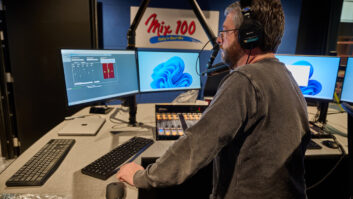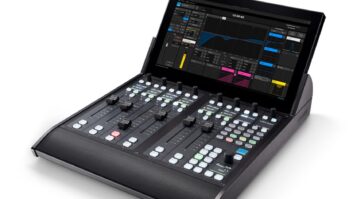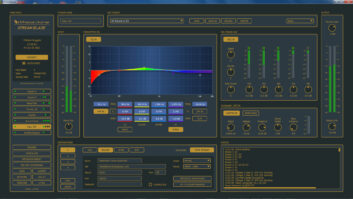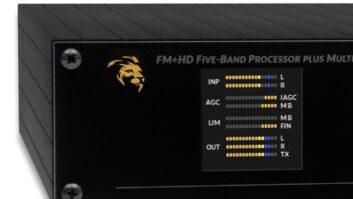Over-the-air audio processing remains a crucial topic despite the multimedia nature of radio today.
In this month�s Trends in Technology column, we�re going to take a look at current offerings by manufacturers whose names you probably know as well as some you might not, including flagship products as well as medium- and lower-priced offerings. All are worthy of your attention.
Many features in previous models have been incorporated in the Wheatstone AirAura X4, including composite processing with selectable look-ahead limiting or clipping, baseband192 composite AES connectivity and a full set of analysis displays.

The AirAura X4 is Wheatstone�s flagship FM on-air processor. It makes use of 31-band limiting, but as part of the X4 system, the 31-band limiter works directly with the X4 clipper, providing �an audio blueprint for how the clipper should behave,� according to Wheatstone. Inside the processor information is shared between all stages � the iAGC, limiters and clipper. Many of the features in previous models have been incorporated in the AirAura X4, including composite processing with selectable look-ahead limiting or clipping, baseband192 composite AES connectivity and a full set of analysis displays. The AirAura X4 adds a number of other new features as well, including a redesigned bass processor, and insert points that allow the end user to insert ratings encoders in the processing system as opposed to ahead of it.
Wheatstone�s HD/FM audio alignment makes the jump to the AirAura X4 as well. The system works either with third-party HD/FM modulation monitors or by itself, with the new FM/HD tuner that is built in to the X4.
Features of the Wheatstone FM-55e include a diversity delay of 0�10 seconds, FM peak control via oversampled distortion masked clipper and Ethernet-based remote control.

As a less expensive option, consider Wheatstone�s FM-55e. It includes the same features of its predecessor the FM-55, but �adds enhanced iAGC controls as well as an entirely new bass processing design,� according to Wheatstone. The heart of the FM-55e is its five-band AGC technology (called iAGC) coupled to a five-band limiter and stereo generator, plus five-band stereo enhancement and program-adaptive L-R control for multipath mitigation.�The FM-55e fully supports the WheatNet-IP and is equipped with two analog composite outputs, two SCA inputs, balanced analog Left/Right outputs and an AES digital output that can be switched to deliver either discrete Left/Right or baseband192 digital multiplex signal.
The FM-55e comes in a 1RU package with front panel OLED display and GUI navigation. (Front-panel setup and configuration menu eliminates the need for a PC during installation.) Some of its other features include diversity delay of 0�10 seconds, adjustable in 100 �S steps via the GUI or ACI; FM peak control via oversampled distortion masked clipper; AES3 digital inputs that accepts 32�96 kHz SR; Guru GUI, for easy setup and navigation; Ethernet-based remote control via 100BaseT Ethernet and rear panel RJ-45; and four GPI preset triggers.
The Wheatstone AM-55 interfaces with the WheatNet-IP Intelligent Network, making it possible for broadcasters to stream its audio to and from anywhere in the IP audio network.

If you are in the market for AM processing, you should take a close look at Wheatstone�s AM-55. It includes five-band AGC technology (called iAGC) coupled to a five-band limiter. The AM-55 accepts analog and digital sources and automatically switches sources upon loss of the primary signal. It interfaces with the WheatNet-IP Intelligent Network, making it possible for broadcasters to stream its audio to and from anywhere in the IP audio network. The AM-55 uses 1RU, features a front panel OLED display, Guru GUI navigation and front-panel headphone jack. Other features of the AM-55 include bass management, an integrated diversity delay of 0-10 seconds, adjustable in 100 �S steps via GUI or ACI; and four GPI preset triggers. Front panel setup and configuration menu eliminates the need for a PC during installation.
The flagship audio processor from the Telos Alliance remains the Omnia.11, and it now ships with the G-Force Dynamics Engine as standard equipment. (G-Force is also available as an optional Plug-In for Omnia.11 units already in the field.)
The Omnia.11 now ships with the G-Force Dynamics Engine as standard equipment; G-Force is also available as an optional plug-in for Omnia.11 units in the field.

Omnia.11 is available in FM+HD with separate processing paths for FM and�HD (or DRM) and FM without HD/DRM. (The FM-only model is upgradeable to FM/HD at a later date.) Omnia.11 takes up four rack units of space and has Livewire, AES/EBU digital and analog input and outputs, two composite outputs, and an MPX Composite Baseband over AES (called Omnia Direct), which is an AES/192 KHz sample rate version of the composite signal. A front panel touch screen GUI, on a 10.5-inch diagonal screen, provides access to control, metering and diagnostics. Remote access is available via any web browser. The unit is uses fan-less cooling.
Also included as standard equipment in the Omnia.11 are static RDS; analog, AES/EBU or Livewire patch points; a patch point location for PPM so�the user can integrate a Voltair/Encoder combo into the audio processing chain; patch point input and output meters for easy level references; and compatibility with the DaySequerra Time Lock system. The user can also select whether the HD processing is fed with the signal that goes through the patch point or not, allowing for separate PPM watermarking of HD/digital streams.
Omnia Volt has analog, AES/EBU and Livewire AoIP inputs; analog, AES/EBU, Livewire and composite outputs; and switchable insert points for Voltair, watermark encoders or other downstream encoding.

If you need a less expensive option, consider the Omnia Volt, introduced at the spring NAB Show. It features six separate AGC sections � one wideband, plus five separate time-aligned multi-band sections, along with five separate time-aligned limiters, each with separate drive, hold, threshold and attack/decay. Volt also features the Omnia �Sensus� algorithm, which (according to them) predicts how HD, DRM, or multicasting data reduction will affect your sound, and pre-conditions the audio accordingly. Volt has analog, AES/EBU and Livewire AoIP inputs; and analog, AES/EBU, Livewire and composite outputs. Like the Omnia.11, it features switchable insert points for Voltair, watermark encoders, or other downstream encoding.
Some of Volt�s other features include an embedded HTML-5 Server for full control from any computer, tablet, or smartphone; 1 RU size; fan-less cooling; and a built-in tone generator to help with setup and calibration.
Omnia.7 features three-stage wideband AGC, program-dependent two- to five-band multiband AGCs and limiters, and asymmetrical output with 150-percent maximum positive peak modulation capability.

I haven�t forgotten about AM processors � if you are looking for a new one, consider the Omnia.7. Among its features is something Omnia calls Undo, which the company says �removes distortion and mathematically re-creates the peaks sliced from today�s poorly mastered contemporary music.� Omnia.7 features multiband downward expansion (source noise reduction); three-stage wideband AGC with adjustable sidechain equalization and program-dependent two- to five-band multiband AGCs and limiters. It�s capable of asymmetrical output with 150-percent maximum positive peak modulation, 100-percent maximum negative peak modulation, and peak inversion controls for the input and output audio. As an option, it can also process HD and/or streaming audio.
Omnia.7 includes a 4.3 inch (10.9 cm) front-panel screen and also full remote control with audio monitoring.
Orban�s flagship FM on-air processor, the 8700i, is AES67-compliant, using Dante for audio-over-IP connectivity, with dedicated dual-redundant Ethernet connections.

The Optimod-FM 8700i is Orban�s flagship processor. The heart of the processor is its five-band (or two-band) processing for both analog FM transmission and digital media, and a new feature the Orban folks showed off at the recent NAB Show called� Xponential Loudness,� which �brings hyper-compressed music back to life, revealing detail and increasing impact while reducing listening fatigue and distortion.� The 8700i�s analog and AES3 digital inputs and outputs are provided with hard-wire safety bypass relays in case of hardware or power failures. It�s 100-percent AES67 compliant, using Dante for audio-over-IP connectivity, with dedicated dual-redundant Ethernet connections for two stereo audio inputs and two stereo outputs, each with a dedicated level control. The unit has two independent composite outputs, and a 384/192 kHz AES3 digital composite output that is compatible and interoperable with the 192 kHz standard being implemented by several transmitter manufacturers.
Some of the other features of the 8700i include a 10 MHz reference input, allowing the pilot and digital composite output sample rate to be locked to a 10 MHz reference signal (like GPS), facilitating single-frequency-networks; a streaming monitor output which, in cooperation with Optimod PC Remote software, allows the user to listen to the station�s sound even where off-air monitoring is unavailable. The steaming feature allows you to monitor several points within 8700i. And, the 8700i has dual power supplies with independent AC line inputs.
The Orban 5700i features a loop-through connection to enable a ratings encoder to be inserted at the output of the AGC before the analog-FM and HD processing paths split or between the output of the audio processing and the input to the stereo encoder.

If you need a less expensive option, you could consider Orban�s Optimod-FM 5700i. It features analog and AES3 digital inputs and outputs, with sample rate converters operating at 32 kHz, 44.1 kHz, 48 kHz, 88.1 kHz and 96 kHz sample rates. The pre-emphasis status and output levels are separately adjustable for the analog and digital outputs: Each output can emit the analog FM processed signal, the analog FM processed signal with diversity delay applied, the digital radio processed signal or the low-delay monitor signal. A loop-through�connection is provided to enable a ratings encoder (such as Nielsen) to be inserted at the output of the AGC before the analog-FM and HD processing paths split or between the output of the audio processing and the input to the stereo encoder. Failsafe switching�detects loss of audio on the primary input; if audio is lost on the primary input, the 5700i can switch automatically to the secondary input.
The 5700i has two independent equalizers, multiband compressors, and peak limiters for the FM analog and digital media processing channels,�allowing you to separately optimize the processing for each. A defeatable diversity delay�can delay the FM analog processing output up to 16.2 seconds; the delay can be trimmed in intervals of one sample of 64 kHz to�match the analog and digital paths�in the HD Radio system,�permitting the 5700i�s internal stereo encoder and composite limiter to drive the analog FM exciter. The 5700i has two independent composite baseband outputs using line drivers that enable them to drive 100 feet of RG-59 coaxial cable without audible performance degradation.
The Orban 9400�s two sets of analog stereo outputs and two AES3 outputs accommodate as many as four transmitters. Asymmetry in its analog outputs provides for 150-percent positive peak modulation.

Orban�s AM processor � the 9400 � has been around for some years, but let�s review its salient features. It�s a 2RU device, with AES 3 and analog inputs. Two sets of analog stereo outputs and two AES3 outputs�accommodate as many as four transmitters. (Asymmetry�in its analog outputs provides for 100�150 percent positive peak modulation.) The 9400 controls the transmitted bandwidth of the analog channel as necessary to meet government regulations: The high-frequency bandwidth of the analog processing channel can be switched in 500 Hz increments between 4.5 kHz and 9.5 kHz. The 9.5 kHz filter meets the requirements of the NRSC-1 standard (North America). The 5.0 kHz filter makes the analog AM bandwidth compatible with HD-AM transmission.
Factory presets�for the 9400 can accommodate �almost any� user requirement. Two Less-More controls (one for the analog processing chain and one for the digital chain) easily modify any factory preset. The user (via Full Modify) can further customize the presets, and these can be stored and recalled on command. The 9400 is remote-controlled�by 5-12V pulses applied to eight programmable, optically isolated inputs, or the 9400PC Remote software, which�runs under Windows Vista, 7, 8, 8.1 and 10, and communicates with a given 9400 via�TCP/IP�over modem, direct serial�or Ethernet�connections.
Attentive processor users know there are a range of options in the market, beyond the so-called flagship class. There are plenty of reasons to be in the market for less expensive processors whether or not you have one of the flagships in everyday use. Not all stations can afford multiple copies of a flagship, and need something a little less expensive as a backup; some stations will find that their needs are more than satisfied with something that doesn�t have as much budget impact.
The BW Broadcast DSPXtra Encore AM, FM & HD Audio Processor is configured by the user to be a processor optimized for FM, AM, digital radio or internet radio streams.

BW Broadcast�s DSPXtra Encore AM, FM and HD audio processor is configured by the user to be a processor optimized for FM, AM, digital radio or internet radio streams. It features Ariane RMS audio levelling and dozens of factory presets. �Experts can also tweak hundreds of parameters as much as they desire,� according to BW.
The unit includes both analog and AES inputs, and also �Plan B� silence detection and source switching that automatically reverts to auxiliary audio sources or on-board flash memory in the event that main sources of audio are lost. Its built-in stereo generator has peak limiting for �advanced anti-aliased distortion control or peaks and bandwidth.� The built-in RDS encoder (UECP compliant) allows the end user to transmit ID, song and title information.
Web access for the DSPXtra Encore is via its built-in HTML5 browser, FTP, Telnet or SNMP. RS232 Remote Control is available as well, as is GPIO. SHOUTcast client and server for streaming in and out of the box allow the end-user to monitor and control the unit from anywhere.
A closeup of the DEVA DB64. Basic features are AES/EBU and analog inputs, a 4-band processing section, and an internal stereo generator with two independent composite MPX outputs.

The DB64-FM is a new FM processor from DEVA. Its basic features include analog and AES/EBU digital audio inputs (and the ability to detect signal loss and switch between the two) which drive a wideband AGC and four-band processing section, followed by a �controlled distortion� limiter driving an internal stereo generator with two independent composite MPX outputs. (The DB64-FM has AES/EBU outputs as well.)
Some of the features that make it more interesting and even more useful are its built-in web server for remote control access via IP; a built-in DSP-based RDS/RBDS encoder; bright, wide view angle OLED and full-time LED meters; single RU design; setup and operation via the front panel, and front-panel headphone jack with level control; and, a bypass and test tone mode. A built-in SNMP agent permits full device management remotely via IP, and SNTP can be used for automatic synchronization of the built-in clock.
The Inovonics Novia 272 incorporates an intuitive, multi-language menu-driven setup as well as a web browser interface compatible with any PC or mobile device.

Inovonics recently introduced its Novia 272 FM Stereo Processor, a half-rack, single RU digital audio processor with a stereo generator and RDS. The processing section includes gated and �windowed� gain-riding AGC, three bands of dynamic compression with selectable crossovers and four sections of parametric EQ plus a �Bass Punch� feature. It accepts analog, AES-digital, and streaming inputs (from SHOUTcast and ICEcast encoders); outputs include MPX and streaming. Multiple factory and user-defined processing presets simplify the setup process. Novia 272 incorporates an �intuitive, multi-language menu-driven setup� as well as a web browser interface compatible with any PC or mobile device. IP connectivity also provides local and email failure alarms, plus complete SNMP support. GPIO controls are available as well.
The Inovonics 223�s DSP-based design provides gated and windowed gain-riding AGC, a three-band processing section and �look ahead� peak control.

Inovonics makes AM processors as well, for example, their 223. It�s a one-third rack width, one RU in height, DSP-based design that provides gated and windowed gain-riding AGC, three bands of adjustable dynamic range compression with selectable crossovers and variable EQ, and �look ahead� peak control. Pre-emphasis, with its own protection limiting and overshoot-controlled output filtering. is individually and specifically tailored to the service selected. The 223 can serve any one of these applications: NRSC-compliant AM broadcasting with a range of cutoff frequencies; Traveler�s Information Service advisories; monaural LPFM transmission; and analog SCA subcarriers. A full-range �Studio� mode satisfies mic processing and general production needs.
The 223 is a model of simplicity. Input and output are all you need.

A dozen years ago each of us had one �stream� per radio station, and over-the-air processing was something that received just about all of the attention; but now, with the addition of streaming audio, video (in some cases) and podcasting, one would almost think that over-the-air processing may have slipped in importance. The reality is that the majority of our listeners still hear us over the radio, so it�s important not to forget about that link and the attendant quality needed to hold on to them.












